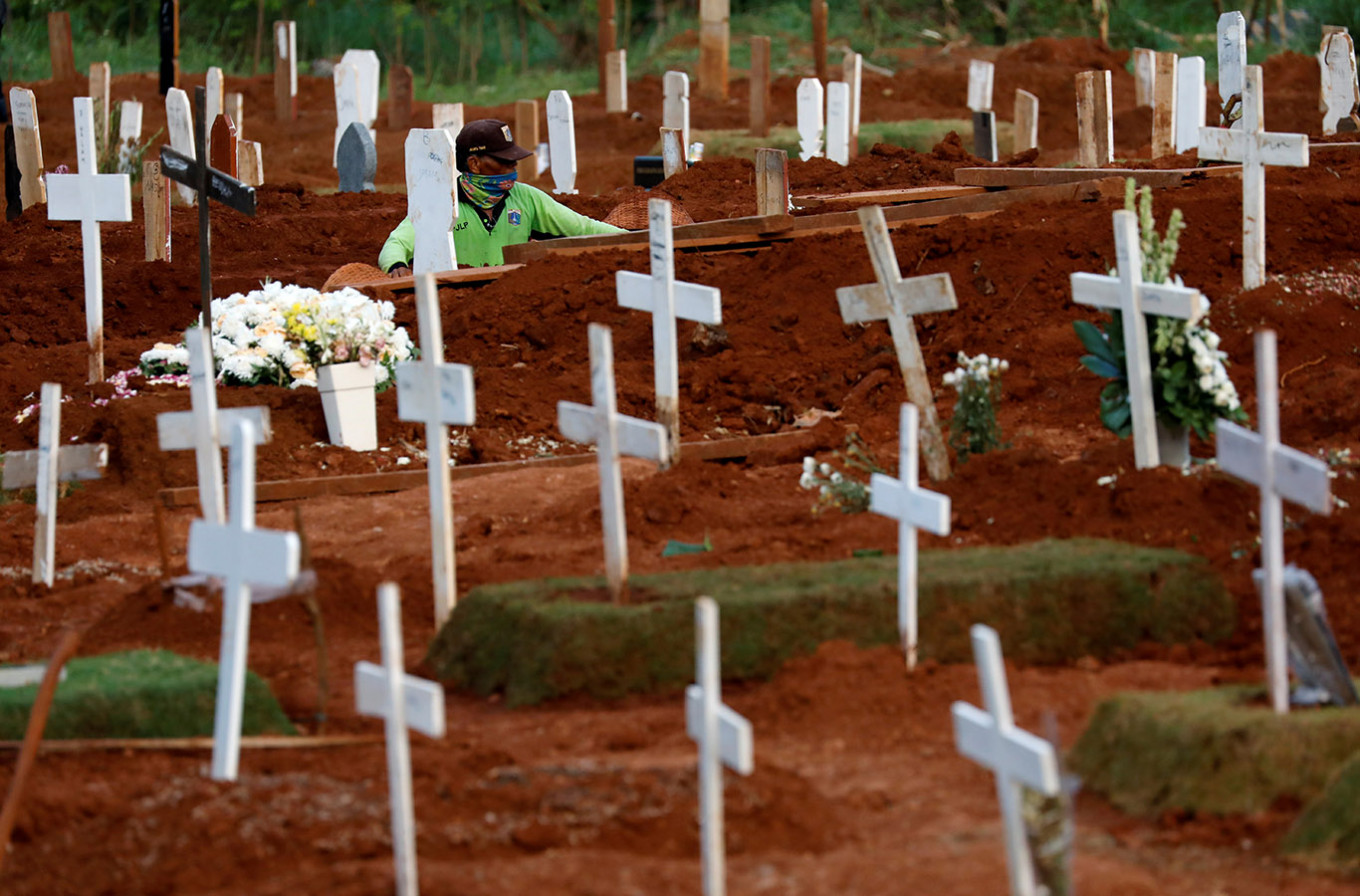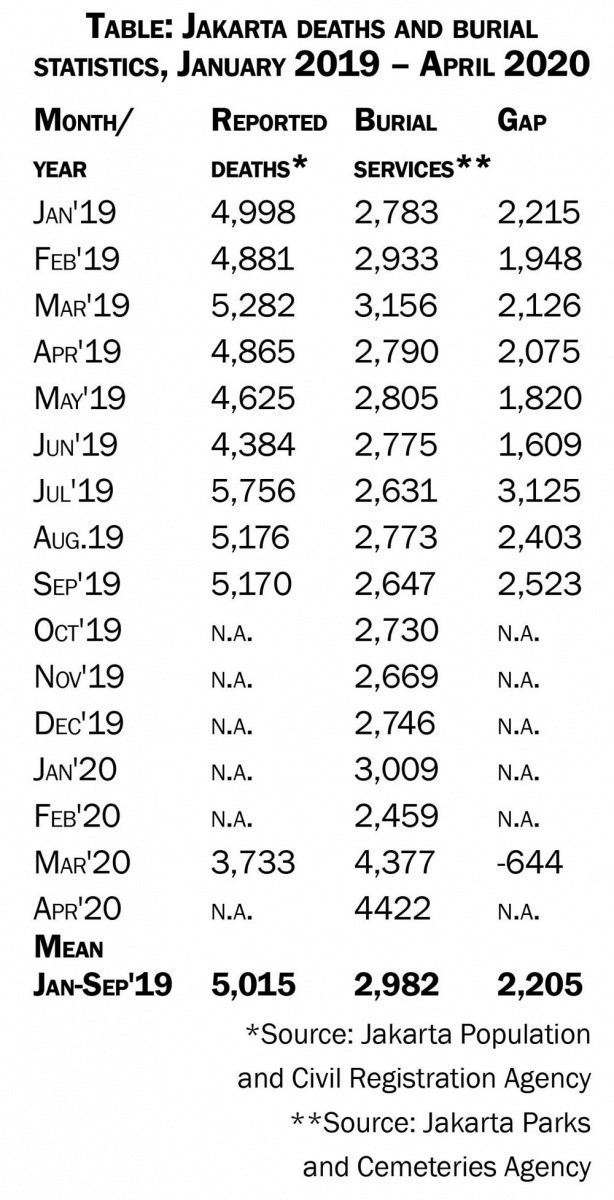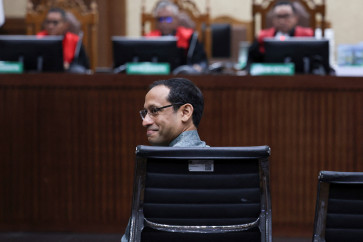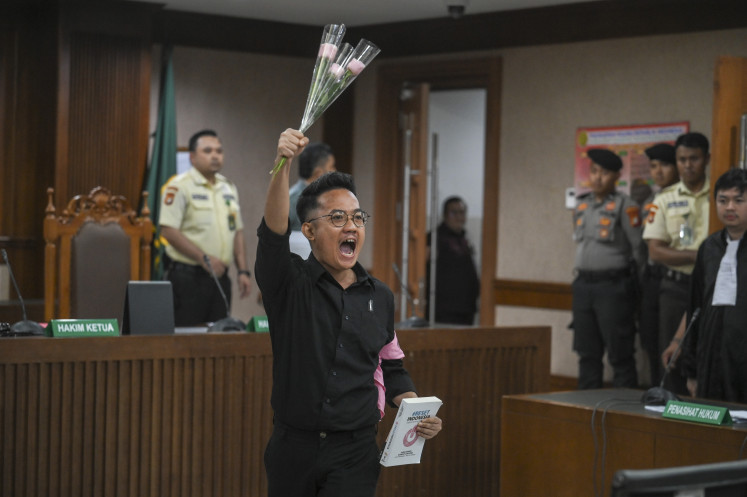Popular Reads
Top Results
Can't find what you're looking for?
View all search resultsPopular Reads
Top Results
Can't find what you're looking for?
View all search resultsBehind Jakarta's recent 'spike' in burials
When the pandemic hit the country since early March 2020, social distancing and self-isolation measures forced people to bury the deceased as soon as possible at the closest cemeteries.
Change text size
Gift Premium Articles
to Anyone
A
mid the pandemic, the increasing number of funerals in Jakarta, Indonesia’s epicenter of COVID-19, have earned the spotlight. During March and April 2020, around 4,400 monthly burials occurred, which is 40 percent higher than any month since at least January 2018.
The headlines were sourced from Jakarta Governor Anies Baswedan. For example, on April 2, The Jakarta Post headlined “People are dying, Pak Ma’ruf: Anies reports Jakarta’s harrowing situation to Vice President.”
What Anies’ dramatic statements did not reveal is that the burial data is not Jakarta’s only monthly death-related statistics. The more accurate statistics are the total reported deaths in the capital city.
These two different sets of statistics are published by two different agencies under the Jakarta municipality. While data on burial services are published by the Parks and Cemeteries Agency, the Population and Civil Registration Agency is responsible for the data on reported deaths.
The table below compiles monthly data for those two statistics from January 2019 to April 2020. Unfortunately, the data on monthly reported deaths are available only up to September 2019. The reported deaths for March 2020 is still a temporary figure at the time of writing, while data for the other months are not available (see table).
Jakarta deaths and burials statistics (JP/File)From January to September 2019, the average monthly reported deaths and burial services are 5,015 and 2,982, respectively. The average gap is 2,205 between those two figures. This means that around 44 percent of people who died in Jakarta were not buried in Jakarta administration cemeteries. Many Indonesians still maintain the tradition of burying the deceased in their place of origin outside the capital. Others may choose private or family cemeteries or cremation services.
When the pandemic hit the country since early March 2020, social distancing and self-isolation measures forced people to bury the deceased as soon as possible at the closest cemeteries. This is the logical explanation for Jakarta’s skyrocketing number of burials in March and April 2020.
As a PhD trained scholar, Anies should know this simple explanation. But instead, he tendentiously told Reuters in early April 2020, “It is extremely disturbing. I’m struggling to find another reason than unreported COVID-19 deaths.”
In the COVID-19 era, Anies is about the only sitting official adored by the masses who supported the camp opposing President Joko “Jokowi” Widodo in the presidential election. The post-election tension is still palpable; his burial statements clearly corner the central government for not handling the pandemic well.
On social media local and foreign academics have expressed suspicions that the central government has manipulated the COVID-19 death toll based on their analysis of Jakarta burial services data only, the statistics misleadingly highlighted by Anies. Without accompanied by data on the total deaths, the burial service data means little.
Even if one assumes that around 4,400 monthly burials in Jakarta during March-April 2020 closely describe the death statistics, these figures are still well below the average of 5,000 monthly deaths last year.
Furthermore, without data on monthly total deaths, the number of bodies buried according to the COVID-19 procedure also means close to nothing. This is another statistic misleadingly cited by Governor Anies. In fact, many of those who died, who had either tested positive or were suspected of COVID-19 infection, had also died from other diseases. Hence, one may assume that COVID-19 has killed significantly more people in Jakarta if and only if the total deaths during the pandemic are significantly higher than the numbers prior to the pandemic.
An internist working in a non-COVID-19-referral hospital in Bekasi, near Jakarta, reported in social media that recently her hospital had become quieter with fewer patients. It seems people are avoiding hospitals out of fear of virus contagion. Yet many non-COVID-19 patients then come to her hospital in severe conditions, to the point that medical intervention cannot help much.
This horrible situation might be the outcome of hyperbolic statements on avoiding contagion released by government officials and spread by media seeking bombastic quotes. The public pays for the cost unnecessarily by avoiding hospitals until it is likely too late.
On the other hand, denials and ignorant statements by officials in the early stage of the pandemic were also dangerous in creating the public’s false sense of security.
What is urgently needed now in this pandemic situation are balanced government messages. Both President Jokowi and Governor Anies must learn from other world leaders. Singapore’s Prime Minister Lee Hsien Loong and New York Governor Andrew Cuomo are good examples of effective leaders’ communication of the pandemic-related situation and directions to their people.
An effective communication strategy is key to winning public trust. And, in turn, public trust is a key element for effective mitigation strategies.
Furthermore, Anies must provide the reported death statistics as soon as possible, then announce it publicly. In a pandemic, a seven-month lag on death statistics does bring into question the capability of his administration.
The accurate death toll would provide a proper basis for the central government and the Jakarta municipality to collaborate in designing a better mitigation strategy for Jakarta as the epicenter of the pandemic.
______
Researcher, statistician, chair of education commission at the Department of Resources and Environmental Economics, School of Economics and Management, Bogor Institute of Agriculture (IPB University). The views are personal.










